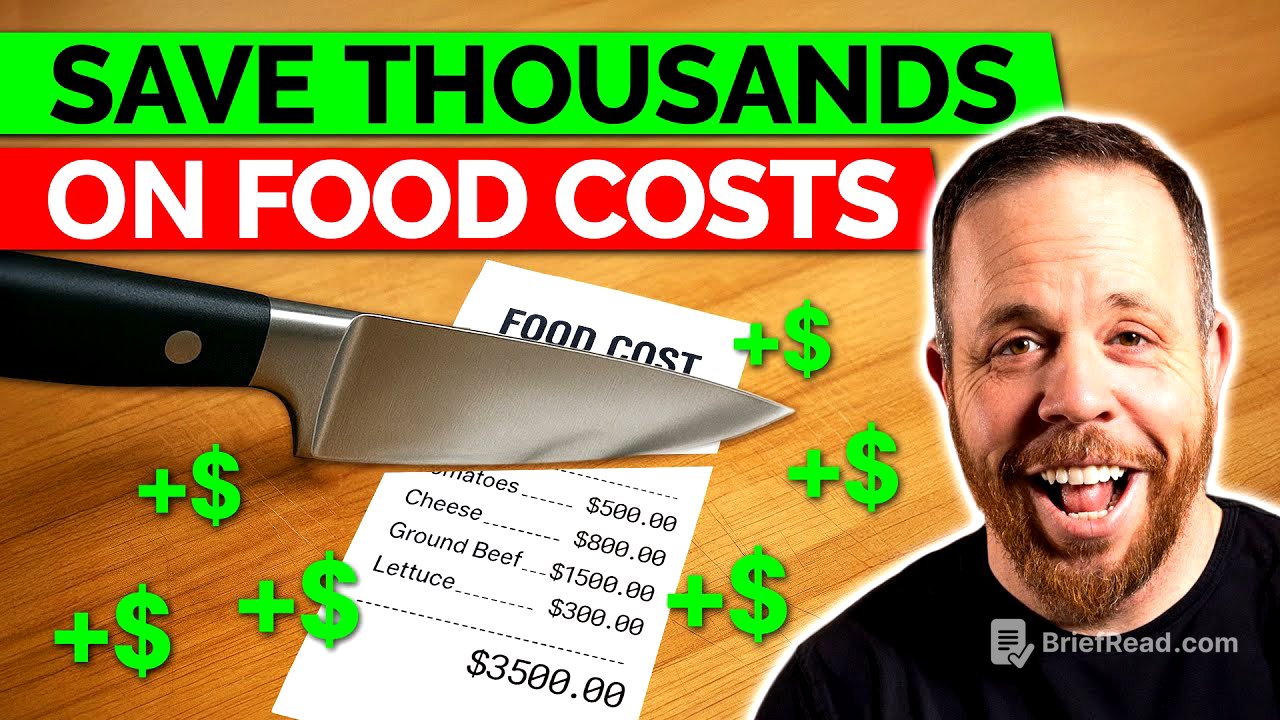TLDR;
This video provides a comprehensive guide for restaurant owners on how to effectively lower food costs and improve profitability. It emphasizes the importance of knowing your actual food cost, implementing strict portion control, engineering a profitable menu, training staff on waste reduction, negotiating with vendors, controlling inventory, and consistently tracking food costs.
- Knowing actual food cost
- Tightening portion control with visuals
- Engineering a profitable menu
- Training staff on waste reduction
- Negotiating with restaurant vendors
- Controlling your pars
- Tracking your food cost
How to know your actual food cost [0:00]
Knowing your restaurant's actual food cost is crucial for profitability. Most owners have a general idea but lack precise figures. To determine this, calculate the recipe cost for each item down to the gram, creating a build sheet detailing the cost of all ingredients. It's essential to differentiate between intended and actual food costs, reassessing these weekly to address any discrepancies. Calculate your real food cost weekly by comparing total invoices to revenue, providing a cash percentage for accurate tracking.
How to tighten portion control with visuals [2:50]
Implement strict portion control using visual aids to ensure consistency. Replace vague terms like "handful" or "pinch" with precise measurements such as slices, cups, or specific tools. Use visual guides like PDFs or charts on the makeline to help staff accurately portion ingredients. Consider pre-bagging portions of expensive items like mozzarella to reduce waste and speed up the makeline process. This provides clarity for staff, ensuring they know the correct portion sizes and can replicate them consistently.
How to engineer a profitable menu [4:48]
Engineer your menu to maximize profit by identifying high-margin and low-margin items. Focus on highlighting high-margin items prominently on the menu, using visual cues to draw attention to them. If a popular item has a low margin, consider increasing the price, as customers often prioritize experience over value. Simplify the rest of the menu to reduce ingredients, minimize waste, and improve prep time. Cross-utilize ingredients to make the most of your inventory and streamline operations.
How to train your staff on waste reduction [6:39]
Train your kitchen staff on waste reduction by emphasizing precision before speed, particularly in portion control. Implement FIFO (First In, First Out) to manage inventory and reduce spoilage. Repurpose items that might otherwise be discarded. Install a food waste log to track discarded items, comps, and donations, fostering transparency and accountability. Encourage staff to record waste without feeling guilty, emphasizing that it helps identify areas for improvement and cost reduction.
How to incentivize your restaurant employees [7:38]
Incentivize your team to reduce waste by demonstrating how small reductions can lead to significant revenue gains. Create buy-in by showing staff the financial impact of their actions and reward them for achieving waste reduction goals. This can include offering small rewards for avoiding waste or larger bonuses for reducing overall food costs. By involving staff in the process and aligning their goals with the restaurant's, you foster a sense of ownership and collaboration.
How to negotiate with restaurant vendors [8:41]
Negotiate with vendors regularly, aiming for a mutually beneficial partnership. Initiate conversations about shared goals and explore options like bulk pricing, vendor rebates, or locking in prices for extended periods. If a vendor is unresponsive or uncooperative, consider interviewing other vendors to create leverage. Prioritize vendors who support your goals and contribute to your cash flow.
How to control your pars [10:34]
Control your pars by accurately assessing the quantity of items on your shelves and avoiding over or under ordering. Count every item to determine your current stock levels and compare them to your ideal par levels. Combine FIFO practices with par management and inventory control to maintain a cohesive system. Avoid having excessive stock, which can lead to waste, but ensure you have enough to meet demand without running out.
How to track your food cost [11:39]
Track your food cost weekly and share this information with your staff to promote awareness and accountability. Compare your current food cost percentage to your target and investigate any discrepancies. Use the knowledge of your invoices versus cash in the bank to identify areas for improvement and address negative trends. Consistent tracking enables you to make informed decisions and proactively manage your food costs.









